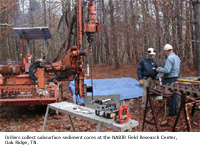
V. The NABIR Field Research Center (FRC)
 The NABIR FRC provides a site for investigators to conduct field-scale research and to obtain DOE-relevant subsurface samples for laboratory-based studies of bioremediation (See figure at right). The FRC is located on the U.S. Department of Energy Oak Ridge Reservation in Oak Ridge, Tennessee; it is operated by the Environmental Sciences Division of the Oak Ridge National Laboratory. The contaminated and background (uncontaminated control) areas are located in Bear Creek Valley (BCV) within the Y-12 Plant area. See http://www.esd.ornl.gov/nabirfrc for more information on the NABIR FRC.
The NABIR FRC provides a site for investigators to conduct field-scale research and to obtain DOE-relevant subsurface samples for laboratory-based studies of bioremediation (See figure at right). The FRC is located on the U.S. Department of Energy Oak Ridge Reservation in Oak Ridge, Tennessee; it is operated by the Environmental Sciences Division of the Oak Ridge National Laboratory. The contaminated and background (uncontaminated control) areas are located in Bear Creek Valley (BCV) within the Y-12 Plant area. See http://www.esd.ornl.gov/nabirfrc for more information on the NABIR FRC.
The contaminated research site is a 98-hectare plot containing uranium, nitrate, technetium, strontium, and cadmium in groundwater, soils, and sediments. To a lesser extent, metals such as mercury, copper, zinc, and lead, and organics such as acetone, methylene chloride, tetrachloroethylene, and toluene are also present. The contaminated area includes the commingled groundwater plumes that originated from a combination of the S-3 Waste Disposal Ponds and the Bone Yard/Burn Yard. Both the background and contaminated areas are well-characterized and well-instrumented, and should be available for a duration of five to ten years. The water table resides between 0 and 3 m below the surface and is readily accessible to multilevel groundwater monitoring wells.
The initial focus of NABIR field research is on in situ biostimulation experiments to promote immobilization of uranium. Understanding natural and stimulated uranium biotransformation in the presence of high nitrate in unconsolidated residuum and fractured rock is one of the biggest challenges at the FRC at Oak Ridge, and at other DOE sites. Two NABIR research projects are underway at the FRC that address in situ immobilization of uranium in the presence of high nitrate. Some of the research questions that are currently being posed include: How can we accurately assess the biotransformation potential in situ ? What are the structure, function, distribution, and activity of microbial communities at the FRC? What nutrients will stimulate bioremediative microbes? How effective will biostimulation be in unconsolidated residuum? In the future, it will be important to also address the hydrodynamics of the system and the pore scale, and the role of fluid flux on mobilization and transport of contaminants.
The FRC is a valuable resource through which NABIR researchers can conduct controlled, field-scale hypothesis testing to answer these and other questions. In addition, the FRC is currently providing subsurface samples for 20 laboratory-based NABIR projects. These projects span all NABIR Science Elements as well as the Assessment Element. Site characterization activities are ongoing and will result in a rich database for use by NABIR researchers. The FRC is responsible for data management, systems integration, and fundamental hydrological and geochemical modeling of the contaminated and background sites. The FRC also makes these data and models accessible to all NABIR researchers.
While the FRC provides a major focus for the NABIR program, it is recognized that other sites that represent different hydrogeological regimes at DOE sites will also be valuable to researchers. A large fraction of the national inventory of DOE wastes resides in unconsolidated, porous media in relatively thick, vadose zones and in groundwaters low in soluble organic carbon. For this reason, NABIR investigators are encouraged to take advantage of opportunities to collect and analyze samples from arid western environments that typify the Hanford Reservation and Uranium Mill Tailings Remedial Action (UMTRA) sites.

